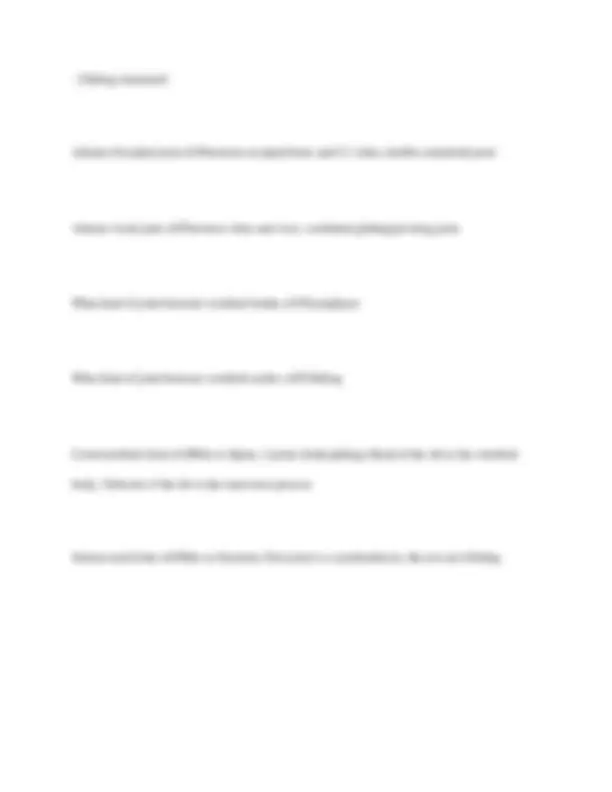









Study with the several resources on Docsity

Earn points by helping other students or get them with a premium plan


Prepare for your exams
Study with the several resources on Docsity

Earn points to download
Earn points by helping other students or get them with a premium plan
Community
Ask the community for help and clear up your study doubts
Discover the best universities in your country according to Docsity users
Free resources
Download our free guides on studying techniques, anxiety management strategies, and thesis advice from Docsity tutors
This comprehensive study guide covers key concepts from uconn's pnb 2264 exam 1, focusing on homeostasis, tissue types, bone structure, and joint classifications. it provides concise definitions, detailed explanations, and numerous examples to aid in understanding complex anatomical and physiological processes. The guide is particularly useful for students preparing for exams in introductory anatomy and physiology courses.
Typology: Exams
1 / 13

This page cannot be seen from the preview
Don't miss anything!








Homeostasis ✔✔"Dynamic steady state" Narrow limits and fluctuations around the "set point"
% of Intracellular fluid in the body ✔✔67%
% of Extracellular fluid in the body ✔✔Interstitial fluid (26%) Blood Plasma (7%)
The Four Tissue Types ✔✔Epithelial, Connective, Muscle, Nervous
Epithelial Tissue ✔✔1. Covers exposed surfaces
Hydrogen and Oxygen combine via: ✔✔Polar Covalent Bonds
Hydrogen's Importance to Life ✔✔- Is a solvent
What does Hydrolysis do? ✔✔Reverses the steps of dehydration synthesis
Electrolytes ✔✔- Hydrogen (H+)
Functions of Epithelial Tissue ✔✔- Protection
Epithelium by LAYERS ✔✔- Simple
Epithelium by SHAPES ✔✔- Squamos
Connective Tissue is made up of: ✔✔- Cells
Functions of Connective Tissue ✔✔- Binding
Connective Tissue consists of specialized cells: ✔✔- Fibroblasts: Make fibers
Matrix determines function and is made up of: ✔✔- Protein Fibers
Types of Fibers ✔✔- Collagenous
Collagenous Fibers ✔✔(Collagen) Stable, triple helix, High tensile strength
Elastic Fibers ✔✔(Elastin) Random coils, extensibility
Reticular Fibers ✔✔(Reticulin=TypeIII Collagen) Supports individual cells of different organs, delicate network
Ground Substance is made of: ✔✔- Interstitial fluid
Hyaline Cartilage ✔✔Lots of dense, fine collagen. Strong, flexible, and smooth and reduces friction in joints
Fibrocartilage ✔✔Collagen, some elastic fibers. EX. Intervertebral disks, resists compression
Two components of Bone ✔✔- Organic (protein) = Osteoid 1/3 bone mass, collagen, property: resists stretch, tensile strength
Osteoblasts ✔✔builds bone
Osteocytes ✔✔Mature bone cells
Osteoclasts ✔✔break down bone
Functions of Bone ✔✔Support, Protection, Allows for Movement, Storage depot for Ca and Phosphorus salts, Hemopoiesis (blood forming)
Classes of Bones ✔✔- Long Bones
Diaphysis ✔✔SHAFT of long bone (hehehehe)
Metaphysis ✔✔M for Middle, as in, in between the Diaphysis and Epiphysis
Epiphysis ✔✔End of long bone
Epiphyseal Disk/Line ✔✔"growth plate" between epiphysis and metaphysis of long bone
Endosteum ✔✔Inner covering of bone (faces marrow)
Endochondral Ossification ✔✔Bone forms on cartilage models
Bone Growth ✔✔As long as Hyaline Cartilage exists at the epiphyseal plate, bone growth can occur. Cartilage proliferation occurs on the epiphyseal side of of the epiphyseal disk. OSSIFICATION occurs on the diaphyseal side
Appositional Growth ✔✔growing in width
Wolff's Law ✔✔Mechanical stress strengthens bone
Calcitonin ✔✔promotes calcium deposition in bone and inhibits osteoclasts (reduces blood calcium levels)
PTH (Parathyroid Hormone) ✔✔increases blood calcium levels by encouraging the resorption by osteclasts
Different Types of Joints: ✔✔- Fibrous Joints: articulate with CT fibers
Joint Classification by Function: ✔✔- Synarthrosis: Immovable
Types of Fibrous Joints: ✔✔- Suture
Sutures ✔✔Synarthrosis EX. skull bones
Syndesmosis ✔✔Slight-give EX. distal tibio-fibular
Types of Cartilaginous Joints: ✔✔- Synchondrosis: Contains hyaline
Synchondrosis ✔✔IMMOVABLE, hyaline connects bones, EX. growing long bones
Atlanto-Occipital joint ✔✔between occipital bone and C1-Atlas, double condyloid joint
Atlanto-Axial joint ✔✔between Atlas and Axis. combined gliding/pivoting joint
What kind of joint between vertebral bodies ✔✔Symphyses
What kind of joint between vertebral arches ✔✔Gliding
Costovertebral Joint ✔✔Ribs to Spine, 2 joints (both gliding) Head of the rib to the vertebral body, Tubercle of the rib to the transverse process
Sternocostal Joint ✔✔Ribs to Sternum, First joint is a synchondrosis, the rest are Gliding